|
Black-Tip- Carcharhinus limbatus
SIZE
To about 6.5 ft (2m).
DISTINGUISHING CHARACTERISTICS
- First and second dorsal fins, pectoral fins, and lower lobe of caudal fin black-tipped (black markings may
fade in adults; may be indistinct in juveniles)
- Anal fin white
- First dorsal fin fairly large with short free tip, originating slightly over or behind insertion of pectoral
fins along inner margin, apex pointed
- Color dark gray, bluish-gray, to dusky bronze above, with light, conspicuous wedge-shaped band or Z-shaped
line on sides beginning near pectoral fins, gradually widening rearward to pelvic fins to merge with white on belly
- No interdorsal ridge
DISTRIBUTION
MA to Brazil, including Gulf of Mexico and Caribbean Sea. Rare north of DE
HABITAT
Shallow coastal and continental shelf waters; surface offshore. Common near river mouths, bays, and
estuaries.
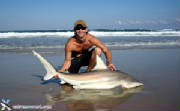



Bull Shark- Carcharhinus leucas
SIZE
To about 11.5 ft (3.5 m).
DISTINGUISHING CHARACTERISTICS
- Snout much shorter than width of mouth and bluntly rounded
- Eyes small
- Body stocky to heavy, especially in adults
- Color pale to dark gray above, white below
- No interdorsal ridge
DISTRIBUTION
NY to Brazil, including Gulf of Mexico and Caribbean Sea. Rare north of DE.
HABITAT
Primarily shallow coastal water; common in lagoons, bays, river mouths; often enters far into fresh water.
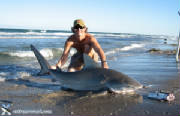



Finetooth Shark- Carcharhinus isodon
SIZE
To about 6 ft (1.8 m).
DISTINGUISHING CHARACTERISTICS
- Snout pointed, shorter than width of mouth; gill slits long
- Fins unmarked, pectoral fin undersides pure white
- First dorsal fin originating behind insertion of pectoral fins along inner margin
- Color bluish-gray above, white below
- Teeth slender, erect, smooth or irregularly serrated; similar in both jaws
- No interdorsal ridge
DISTRIBUTION
NY to FL, including Gulf of Mexico and Cuba. Rare north of NC.
HABITAT
Coastal; inshore shallow waters <20 ft (6 m).
Sandbar Shark- Carcharhinus plumbeus
SIZE
To about 8 ft (2.4 m).
DISTINGUISHING CHARACTERISTICS
- First dorsal fin large, triangular, originating over or slightly before pectoral insertion
- Pectoral fins large, broad
- Snout shorter than width of mouth
- Color brownish-gray or brown above, white below
- Interdorsal ridge
DISTRIBUTION
Cape Cod, MA, to FL, including Gulf of Mexico and Caribbean Sea.
HABITAT
Inshore shallow coastal waters, including bays, harbors, and estuaries; typically in waters 5-180 ft (2-55 m); also offshore,
occasionally to 600-810 ft (183-247 m); bottom dwelling.

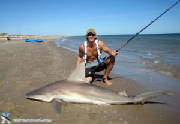
Shortfin Mako- Isurus oxyrinchus
SIZE
To about 13 ft (4 m).
DISTINGUISHING CHARACTERISTICS
DISTRIBUTION
Newfoundland, Canada, to Brazil, including Gulf of Mexico and Caribbean Sea. Common in U.S. Northeast.
HABITAT
Offshore from surface to at least 500 ft (152 m); generally in waters >61°F (16°C).

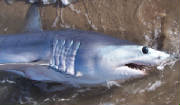
Spinner Shark- Carcharhinus brevipinna
SIZE
To about 9 ft (2.7 m).
DISTINGUISHING CHARACTERISTICS
- Anal, first and second dorsal, pectoral, and lower caudal fins black-tipped (look as if dipped
in jet black paint) in specimens >2.6 ft (0.8 m)
- First dorsal fin fairly small, originating over or just behind free tips of pectoral fins,
apex rounded
- Snout pointed, as long as or longer than width of mouth
- Color gray or bronze above with light, conspicuous wedge-shaped band or Z-shaped line on sides
beginning near pectoral fins, gradually widening rearward to pelvic fins to merge with white on belly
- No interdorsal ridge
DISTRIBUTION
VA to FL, including Gulf of Mexico; possibly into Caribbean.
HABITAT
Coastal and offshore. Common in shallow waters <100 ft (30 m).


Tiger Shark- Galeocerdo cuvier
SIZE
To about 18 ft (5.5 m).
DISTINGUISHING CHARACTERISTICS
- Dorsal surfaces of juveniles covered with dark blotches on bluish- or greenish-gray to black background; blotches fuse
to form tigerlike vertical bars or stripes as shark grows; coloration fades to gray and stripes become less distinct in adults
- Snout blunt and wide, much shorter than width of mouth; long labial furrows around corners of mouth reaching eyes
- Teeth serrated with deep notch on outer margins, similar in both jaws
- Interdorsal ridge low
DISTRIBUTION
Cape Cod, MA, to Uruguay, including Gulf of Mexico and Caribbean Sea.
HABITAT
Coastal waters close inshore to outer continental shelf; offshore including oceanic island groups.
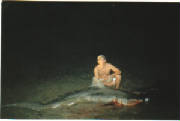
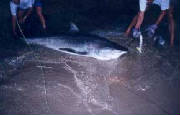
Nurse Shark- Ginglymostoma cirratum
SIZE
To about 9 ft (2.7 m).
DISTINGUISHING CHARACTERISTICS
- Mouth near tip of snout with conspicuous nasal barbels on each side; deep grooves connecting nostrils
with mouth
- First and second dorsal and anal fins broadly rounded; second dorsal fin nearly as large as first
dorsal fin
- First dorsal fin originating well behind pectoral fins and over or behind origin of pelvic fins
- Caudal fin with no distinct lower lobe
- Color dark brown to yellow-brown above; lighter below, occasionally with yellowish hue on underside;
juveniles often with black spots
- Very small eyes
- No interdorsal ridge
DISTRIBUTION
RI to Brazil, including Gulf of Mexico and Caribbean Sea. Rare north
of Cape Hatteras, NC.
HABITAT
Coastal; bottom dwelling; often in or close to coral reefs; young in
very shallow water; adults in progressively deeper water.
SIMILAR SPECIES
Sand tiger and lemon shark have caudal fins with distinct lower lobe;
lack nasal barbels.
|

